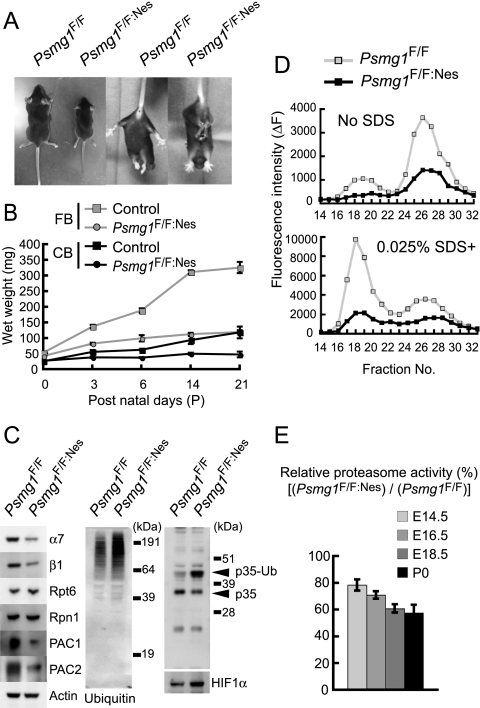FIG. 2.
Decreased proteasome activity in Psmg1F/F:Nes mouse brains. (A) Growth retardation (left two panels) and abnormal limb-clasping reflexes (right two panels) in Psmg1F/F:Nes mice at P21. When lifted by the tail, Psmg1F/F mice behaved normally, extending their hind limbs and bodies. In contrast, Psmg1F/F:Nes mice bent their legs toward their trunk or tightened their back limbs to their bodies and anterior limbs. (B) Impairment of weight gain in Psmg1F/F:Nes brains. Control (Psmg1F/F) and Psmg1F/F:Nes cerebra and cerebella were dissected, and their wet weight was measured on the indicated days. The data are shown as the means ± standard deviations (SD) (n > 3 each). (C) Extracts from Psmg1F/F and Psmg1F/F:Nes brains at P21 were subjected to immunoblot analysis using the indicated antibodies. p35-Ub denotes monoubiquitinated p35. (D) The extracts used for panel C were fractionated by 8 to 32% glycerol gradient centrifugation. An aliquot of each fraction was used for an assay of the chymotryptic activity of the proteasomes using Suc-LLVY-MCA in the absence (upper panel) or presence (lower panel) of 0.025% SDS. (E) Extracts from Psmg1F/F and Psmg1F/F:Nes brains at E14.5, E16.5, E18.5, and P0 were used for an assay of the chymotryptic activity of the proteasomes using Suc-LLVY-AMC as a substrate. The data are shown as means ± SD (n > 3 each) relative activity.

